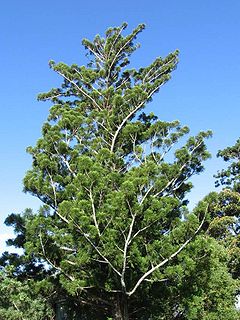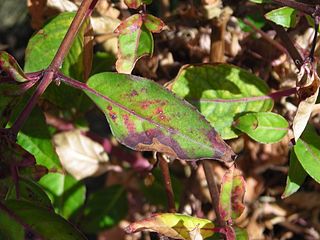
Papua New Guinea, officially the Independent State of Papua New Guinea, is a country in Oceania that comprises the eastern half of the island of New Guinea and its offshore islands in Melanesia. Its capital, located along its southeastern coast, is Port Moresby. It is the world's third largest island country with 462,840 km2 (178,700 sq mi).

Impatiens is a genus of more than 1,000 species of flowering plants, widely distributed throughout the Northern Hemisphere and the tropics. Together with the genus Hydrocera, Impatiens make up the family Balsaminaceae.
Guinea or Guinea-Conakry is a republic in West Africa, independent since 1958.

Araucaria cunninghamii is a species of Araucaria known as hoop pine. Other less commonly used names include colonial pine, Queensland pine, Dorrigo pine, Moreton Bay pine and Richmond River pine. The scientific name honours the botanist and explorer Allan Cunningham, who collected the first specimens in the 1820s.

Cordyline is a genus of about 15 species of woody monocotyledonous flowering plants in family Asparagaceae, subfamily Lomandroideae. The subfamily has previously been treated as a separate family Laxmanniaceae, or Lomandraceae. Other authors have placed the genus in the Agavaceae. Cordyline is native to the western Pacific Ocean region, from New Zealand, eastern Australia, southeastern Asia and Polynesia, with one species found in southeastern South America.

Nepenthes lamii is a tropical pitcher plant endemic to New Guinea, where it grows at an altitude of up to 3520 m above sea level, higher than any other Nepenthes species. Although once confused with N. vieillardii and previously regarded as conspecific with the closely related N. monticola, it is now recognised as a distinct species.

Nepenthes paniculata is a tropical pitcher plant belonging to the genus Nepenthes.
The angulate pipistrelle, also known as the New Guinea pipistrelle, is a species of vesper bat found in Papua New Guinea and the Solomon Islands.

Impatiens necrotic spot orthotospovirus(INSV) is a plant pathogenic virus of the order Bunyavirales. It was originally believed to be another strain of Tomato spotted wilt virus but genetic investigations revealed them to be separate viruses. It is a single stranded RNA It has a tripartite genome and is largely spread by the insect vector of the western flower thrips. The virus infects more than 648 species of plant including important horticultural and agricultural species such as fuchsia, tomato, orchids, and lettuce. As the name implies, the main symptom on plants is necrotic spots that appear on the leaves. The INSV virus infects by injecting the RNA the virus contains into the cell which then starts using the cell resources to transcribe what the virus RNA states. Viral infection can often result in the death of the plant. The disease is mainly controlled by the elimination of the western flower thrip vector and by destroying any infected plant material.

The Maggie Taylor's roundleaf bat is a species of bat in the family Hipposideridae. It is found in West Papua (Indonesia) and Papua New Guinea.
Boutiquea is a monotypic genus of flowering plants in the family Annonaceae containing the single species Boutiquea platypetala. It is native to Cameroon and Equatorial Guinea.

The rough whiting, Sillago nierstraszi, is a dubious species of coastal marine fish in the smelt-whiting family Sillaginidae. The species is known only from the holotype which was collected in 1941 on the south coast of Papua New Guinea, but is thought to be lost. S. nierstraszi is currently a valid species, although during his revision of the sillaginids, Roland McKay suggested the species to be a senior synonym of Sillago analis.

Parsonsia is a genus of woody vines in the family Apocynaceae. Species occur throughout Indomalaya, Australasia and Melanesia.

New Guinea is the world's second-largest island and, with an area of 785,753 km2 (303,381 sq mi), the largest island in the Southern Hemisphere. Located in Melanesia in the southwestern Pacific Ocean, it is separated by the 150-kilometre wide Torres Strait from the Australian continent. Numerous smaller islands are located to the west and east. The eastern half of the island is the major land mass of the independent state of Papua New Guinea. The western half, known as Western New Guinea or West Papua, forms a part of Indonesia and is organized as the provinces of Papua and West Papua.
Impatiens platypetala is variable species of perennial Impatiens discovered on the island of Java and widespread throughout Indonesia. It reaches 1 m (3.3 ft) high, with bright orange flowers that have a white eye in the center. The ovate to lanceolate-ovate leaves are 5 to 12 cm long. It produces the anthocyanin aurantinidin.
Agriculture in Papua New Guinea has a more than 7,000 years old history. Currently around 85% of Papua New Guinea's population lives from semi-subsistence agriculture.
Finschia is a genus of three recognised species of large trees, constituting part of the plant family Proteaceae. They grow naturally in New Guinea and its surrounding region, in habitats from luxuriant lowland rainforests to steep highland forests.

The karuka is a species of tree in the family Pandanaceae and an important regional food crop in New Guinea. The nuts are more nutritious than coconuts, and are so popular that villagers in the highlands will move their entire households closer to trees for the harvest season.
Fontainea borealis is a small tree endemic to Papua New Guinea, in the family, Euphorbiaceae, which grows to a height of 12 m.
Fontainea subpapuana is a small tree endemic to Papua New Guinea in the family, Euphorbiaceae, which grows to a height of 7 m.












